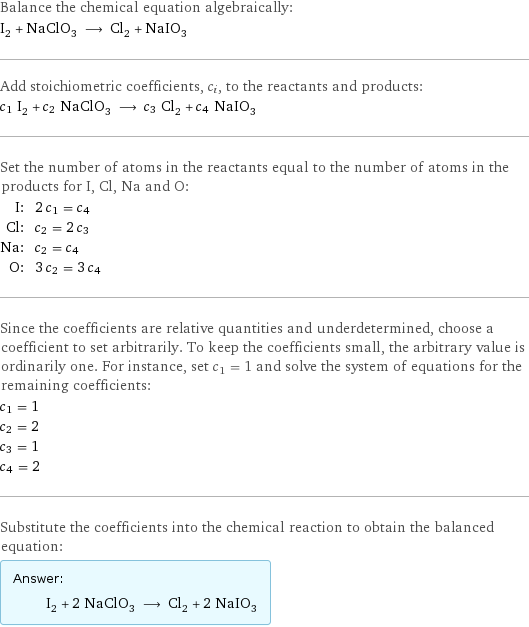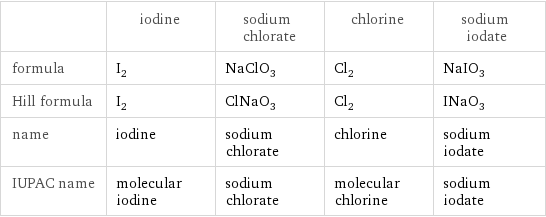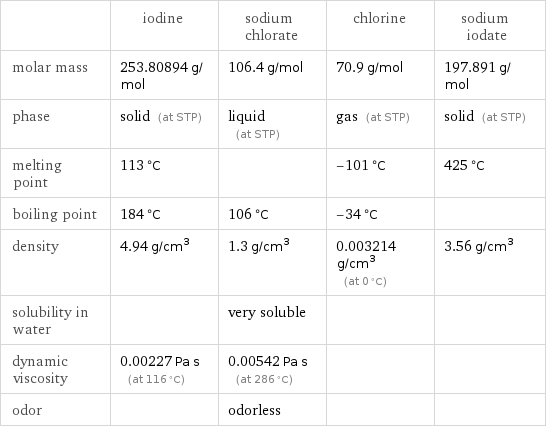Input interpretation

I_2 (iodine) + NaClO_3 (sodium chlorate) ⟶ Cl_2 (chlorine) + NaIO_3 (sodium iodate)
Balanced equation

Balance the chemical equation algebraically: I_2 + NaClO_3 ⟶ Cl_2 + NaIO_3 Add stoichiometric coefficients, c_i, to the reactants and products: c_1 I_2 + c_2 NaClO_3 ⟶ c_3 Cl_2 + c_4 NaIO_3 Set the number of atoms in the reactants equal to the number of atoms in the products for I, Cl, Na and O: I: | 2 c_1 = c_4 Cl: | c_2 = 2 c_3 Na: | c_2 = c_4 O: | 3 c_2 = 3 c_4 Since the coefficients are relative quantities and underdetermined, choose a coefficient to set arbitrarily. To keep the coefficients small, the arbitrary value is ordinarily one. For instance, set c_1 = 1 and solve the system of equations for the remaining coefficients: c_1 = 1 c_2 = 2 c_3 = 1 c_4 = 2 Substitute the coefficients into the chemical reaction to obtain the balanced equation: Answer: | | I_2 + 2 NaClO_3 ⟶ Cl_2 + 2 NaIO_3
Structures

+ ⟶ +
Names

iodine + sodium chlorate ⟶ chlorine + sodium iodate
Equilibrium constant
![K_c = ([Cl2] [NaIO3]^2)/([I2] [NaClO3]^2)](../image_source/e3e78220b5477793fb1d38b1a7eeb060.png)
K_c = ([Cl2] [NaIO3]^2)/([I2] [NaClO3]^2)
Rate of reaction
![rate = -(Δ[I2])/(Δt) = -1/2 (Δ[NaClO3])/(Δt) = (Δ[Cl2])/(Δt) = 1/2 (Δ[NaIO3])/(Δt) (assuming constant volume and no accumulation of intermediates or side products)](../image_source/1aa65c2b63e157e802ae9075f3c003fa.png)
rate = -(Δ[I2])/(Δt) = -1/2 (Δ[NaClO3])/(Δt) = (Δ[Cl2])/(Δt) = 1/2 (Δ[NaIO3])/(Δt) (assuming constant volume and no accumulation of intermediates or side products)
Chemical names and formulas

| iodine | sodium chlorate | chlorine | sodium iodate formula | I_2 | NaClO_3 | Cl_2 | NaIO_3 Hill formula | I_2 | ClNaO_3 | Cl_2 | INaO_3 name | iodine | sodium chlorate | chlorine | sodium iodate IUPAC name | molecular iodine | sodium chlorate | molecular chlorine | sodium iodate
Substance properties

| iodine | sodium chlorate | chlorine | sodium iodate molar mass | 253.80894 g/mol | 106.4 g/mol | 70.9 g/mol | 197.891 g/mol phase | solid (at STP) | liquid (at STP) | gas (at STP) | solid (at STP) melting point | 113 °C | | -101 °C | 425 °C boiling point | 184 °C | 106 °C | -34 °C | density | 4.94 g/cm^3 | 1.3 g/cm^3 | 0.003214 g/cm^3 (at 0 °C) | 3.56 g/cm^3 solubility in water | | very soluble | | dynamic viscosity | 0.00227 Pa s (at 116 °C) | 0.00542 Pa s (at 286 °C) | | odor | | odorless | |
Units
